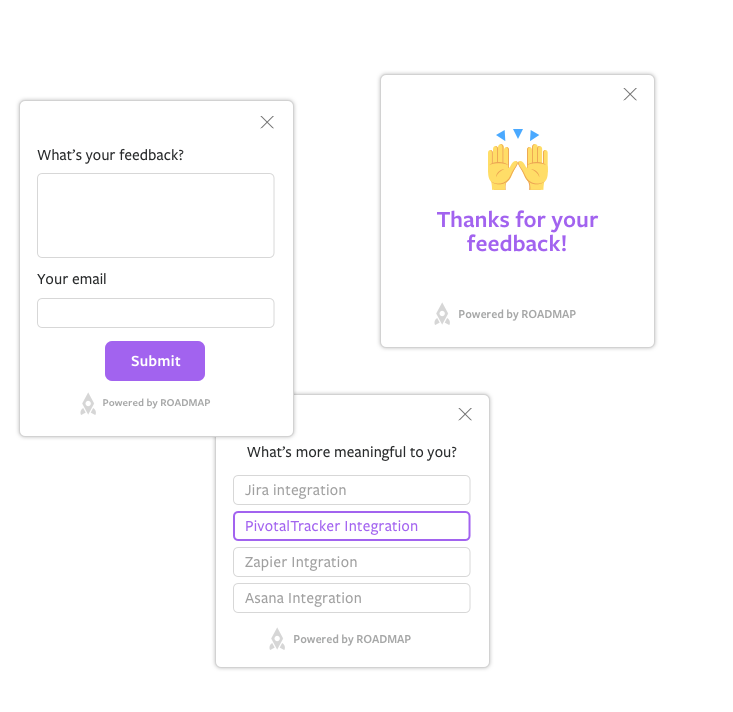
Whether you’re a startup without the budget for user feedback tools or a product manager looking to get started without the fuss, there are a ton of ways to collect user feedback for free.
This list of 10 free user feedback tools can help teams leverage feedback to build better products, without breaking the bank.
UberConference’s meeting software is at the top of the list because while other formats of user feedback are important, the most direct path to shared understanding is via real conversations with users and customers.
UberConference lets you connect for audio calls and screenshares. It’s a snap for guests to use, reliable, and you can even record and share your calls for future reference.
InVision is a prototyping tool that lets designers create interactive mockups. The cool part (besides it being free of course) is that product mangers and designers can share mockups with stakeholders and collaborate via comments right from the mockups.
InVision is a powerful way to visually engage users during user interviews/calls and get feedback before investing development hours into big UX changes. UX Designer and creative director Jeremy Wells shared these 7 reasons to use InVision here.
Typeform makes it so easy to create and share user surveys that people will actually engage with. It’s flexible enough to ask dynamic questions and share in whatever format that works best like a link, on a web page, etc.
Daragh Walsh shares a few tips here on how to use Typeform to do market research. You can also use Typeform to collect customer feedback, survey test/beta groups, or offboard customers.
The free Intercom customer intelligence platform is a way to understand what users are doing in your web app.
For example, you can use Intercom’s free platform to understand which users are engaging with certain features and reach out to them for more relevant feedback.
Slack didn’t just revolutionize the way teams communicate, they also changed the way teams can communicate with external stakeholders too.
For example, when we launched a new product earlier this year we created a public Slack channel to communicate with users and gather feedback in a less formal, more conversational way.
We’re also really excited to be a part of the Product Collective Slack group hosted by the founders Paul McAvinchey & Mike Belsito. Their ‘feedback’ channel is a helpful for getting feedback from product management leaders. Industry specific or social Slack channels can be a great way to grab fresh perspectives and feedback.
Roadmap makes it easy for product teams to collect and centralize data-driven feedback across multiple channels. You can install a feedback widget to your website or app to collect feedback directly from users. You can also use the API to centralize feedback from channels like sales and customer success for free.

User feedback with Roadmap is actionable and people-focused. By focusing on the people influencing product, it helps product mangers close the feedback loop and make sure feedback doesn’t fall through the cracks.
Twitter polls are a quick and easy way to engage your followers for feedback. For example, the team at Gigapixel Gaming created a poll to learn more about the degree of difficulty their next scavenger hunt should be. In addition to quantitative data, the poll also sparked an engaging thread of feedback.
Feedback Poll: How difficult should the next @zotac Scavenger Hunt be?
— Gigapixel Gaming (@GigapixelGam1ng) December 1, 2016
Twitter chats can also be an effective way to get your community talking about your product and sharing feedback. Maurice Rahmey from HubSpot shares a few tips here on how to host effective Twitter chats.
Plenty of brands and products leverage Facebook for user feedback. The advantage of using Facebook for feedback is that your Facebook audience tends to have a more intimate relationship with your product or brand.
People don’t have to go out of their way to engage on Facebook and that increases the likeliness they’ll have a few minutes to share their feedback.
We’ve noticed consumable products and games spark a ton of engagement when they ask their Facebook community for feedback. For example earlier this month DC Universe Online asked their community for feedback on what they should prioritize for 2017. They got a ton of responses and sparked and engaging discussion on everything from game features to community engagement.
BetaList is a platform similar to Product Hunt (which we also love!) and is typically used to launch or learn about beta products.
Launching an MVP with the goal of getting feedback and iterating quickly can be a little intimidating on Product Hunt. You can get a lot of exposure and there is something to be said about getting the most out of the experience.
BetaList is a bit more low-key for launching super early versions of a product. The vibe from the community is that products on BetaList are early stage and are looking for feedback or beta testers. As a result, the community is proactive about giving constructive feedback.
Forms & surveys with G Suite are a fast, simple, and free way to collect user feedback.
While pretty basic in terms of functionality and design, a collective shared understanding around Google’s products make forms easy to create, share, and submit responses. Having your response data in a friendly CSV format is also helpful.